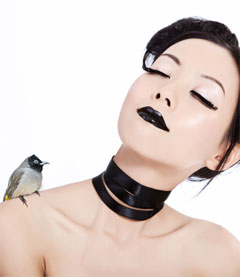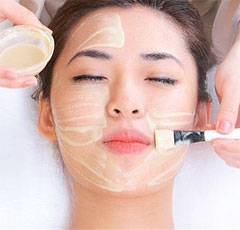|
|
Geisha or Bird Poo Facials: A Strange beauty treatment

There's an old superstition that if a bird happens to poop on you as it's
flying by, you'll have good luck. Some versions specify that the bird poop must
land on your head to count, or that the good luck is only related to money. But
for most of us, bird poop is nothing to be happy about. It's usually just
something we have to wash off our car or maybe ourselves if we're one of the
lucky (or not-so-lucky) few.
There are people, however, who are not only handling bird poop by choice, but
putting it on their faces -- as a beauty treatment. It's the poop of a specific
type of nightingale, the Japanese bush warbler, and it's called uguisu no fun
(literally "nightingale feces") in Japanese.
Using nightingale poop in a facial is an ancient Japanese technique that has
recently started to make its way westward. It's said to make your skin softer
and brighter. High-end spas in New York and other American cities now offer
facials incorporating the poop (called "geisha facials") that can be quite
expensive. The spa Shizuka New York offers the service for $180, for example.
Mail-order companies also sell the ingredients for home use at about $20 per
ounce.
If you're wondering about the smell of bird poop on your face (and how could you
not?), users have described it as anything from "doughy" to "musky" to
"medicinal," while some say that there's no smell at all.
'Uguisu no fun' which literally means �nightingale feces� in Japanese, refers to
the excrement (fun) produced by a particular nightingale called the Japanese
bush warbler. The droppings have been used in facials since ancient Japanese
times. Recently, the product has been used in the Western world. This facial has
been referred to as the �Geisha Facial�. The facial is supposed to lighten the
skin and balance skin tones that have acne or sun damage.
The use of nightingale excrement dates back to the Heian period (A.D. 794 �
1185) where it was introduced to the Japanese by the Koreans. The Koreans used
the guano to remove dye from kimono fabric which allowed them to make intricate
designs on the clothing. The Japanese used the bird droppings to remove stains
from silk garments, like kimonos. Then, during the Edo period (A.D. 1603�1868),
the Japanese expanded the use by using it as a beauty treatment. Some sources,
however, report that as early as the 3rd century, Japanese women rubbed bags of
rice bran on their faces and used nightingale droppings to whiten the skin.
Geishas and kabuki actors used heavy white makeup that contained zinc and lead,
which could have caused skin diseases and other issues. Uguisu no fun was used
to thoroughly remove the makeup and whiten and even the skin. Also, Buddhist
monks used the droppings to polish and clean their bald scalps.
The first modern written mention of the use of uguisu no fun is in a book
entitled Shunkin-sho (Portrait of lady Shunkin) published in 1933 by Jun'ichiro
Tanizaki, set in Japan�s Meiji period (1868-1912). Currently, Hyakusuke is the
last place in Tokyo to have the government-approved uguisu no fun. This
two-hundred year old cosmetic shop carries the powder along with other cosmetic
products. Modern day use of uguisu no fun in Japan may be attributed to a
respect for the ancestral tradition as well as the innovative culture of Japan.
 Uguisu no fun is harvested in nightingale farms in Japan. Though wild
nightingales eat insects and berries, the diet of the caged birds consists of
organic seeds. Some nightingales feed on caterpillars that eat from plum trees.
The guano is scraped from the cages, and an ultraviolet light is often used to
kill the bacteria to sanitize it. The droppings are then usually dried with a
dehydrator. Some are sun-dried for over two weeks while simultaneously being UV
sterilized. Next, it is ground into a fine white powder, and it is sold in this
form. The droppings are turned into powder in a special container that rotates
for 18 hours with a ceramic ball. Uguisu no fun is harvested in nightingale farms in Japan. Though wild
nightingales eat insects and berries, the diet of the caged birds consists of
organic seeds. Some nightingales feed on caterpillars that eat from plum trees.
The guano is scraped from the cages, and an ultraviolet light is often used to
kill the bacteria to sanitize it. The droppings are then usually dried with a
dehydrator. Some are sun-dried for over two weeks while simultaneously being UV
sterilized. Next, it is ground into a fine white powder, and it is sold in this
form. The droppings are turned into powder in a special container that rotates
for 18 hours with a ceramic ball.
Rice bran is sometimes added to the guano for the purpose of exfoliation. The
powder is mixed with water yielding a paste. The paste is massaged into the skin
for a few minutes and then it is rinsed off. The facial is usually rather
odorless and sanitized. The added rice bran can also neutralize the slight musky
odor. In one New York spa that offers the Geisha Facial, the process takes about
one hour and costs $180.
The way the facial works is not entirely clear. The guano from the nightingale
has a high concentration of urea and guanine. Because birds excrete a fecal and
urine waste from a single opening, called the cloaca, the fecal-urine
combination give the droppings a high concentration of urea. Urea is sometimes
found in cosmetics because it locks moisture into the skin. The guanine may
produce shimmery, iridescent effects on the skin. It is claimed that because of
the short intestine of the nightingale, the droppings have protein, a
fat-degrading enzyme, and a whitening enzyme that acts on fat and scurf to
whiten skin and even out blemishes.
Numerous sources comment that "the amino acid guanine" gives uguisu no fun its
cosmetic properties, though guanine is a nucleotide base, not an amino acid. In
popular culture
Victoria Beckham, who has long suffered with acne, used uguisu no fun to improve
her skin. It was reported that Victoria Beckham admired the clarity of the skin
of Japanese women and subsequently learned about the droppings. David Beckham
has been said to use the product as well. In the novel Memoirs of a Geisha,
Chiyo repays Hatsumomo�s cruelty by mixing pigeon droppings with her face cream
that contained unguent of nightingale droppings.
2012 movie Mirror mirror based on the fairytale snow white, the evil queen,
played by Julia Roberts undergoes extreme beauty treatments in order to woo a
price, the treatment begins with an application of bird droppings to her face.
Dated 19 November 2013
|
|
|
|
|
|
|
|
|









